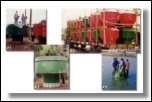 click to enlarge
click to enlarge
|
|
KAE's
G.R.P. Buoys ensures stable, longlife
marking of channels, bays, Rivers
and lakes. G.R.P. material is very
suitable to construct the buoys in
Indian Oceans & Rivers and KAE
manufacturing technology is Time-proven
in every installation.
Method
of Manufacturing |
A
smooth 8 mil Gelcoat on the exterior
Red, White, Green or Yellow prevents
Color fading and weathering. It also
provides good adhesive surface for
retro-reflective markings. The buoy
is completely filled with closed-cell
polyurethane foam for optimum buoyancy.
The Counterweight is of the Cast-iron
with flattened base that provides
a stand for the buoy during storage.
KAE’s finned design makes the
buoy stable in wind and current, heeling
angle is less than 10° in 100
mph. wind. Bolted at the bottom of
the buoy is a 3/16” steel plate,
which is also rigidly attached to
the counterweight. The arrangement
spreads normal stress throughout the
hull, virtually eliminating the possibility
of the counterweight breaking off
the buoy body.
Freeboard is the distance from the
waterline to the buoy deck and constitutes
the reserve buoyancy of the buoy.
Every buoy requires a minimum reserve
freeboard at its maximum mooring depth
in order to resist wind, current and
waves. The Amount of moorings that
the buoy can safely support is calculated
from the available freeboard and the
buoys submerge factor.
Moorings must meet the environmental
conditions at the site, depending
on these conditions, the total conditions,
the total chain length can range from
1.5 times to 4 times the water depth.
The chain must be long and heavy enough
that its weight will reduce the shock
load on the buoy created by force
of the ocean. A minimum freeboard
must be maintained to allow the buoy
to ride high in water even rough seas.
Finally, considerations must be given
to bottom conditions that could cause
excessive wear and abrasion on the
moorings.
The Sinker must be heavy enough to
hold the buoy on the station during
the expected environmental conditions.
Sinkers are normally made of concrete
for economic reasons.
Mooring Maintenance is vital. Depending
on bottom conditions, moorings may
require inspection as often as every
six months for the first couple of
years until the wear pattern is established.
If excessive wear is evident, switching
end for end can extend mooring life.
Buoy Maintenance is governed by environmental
conditions. Normally, the buoy’s
paint system will last for six years.
Anti-fouling paints will help retard
sea grwth. With proper care &
maintainence G.R.P bouys will have
life of 20-25 yrs. |